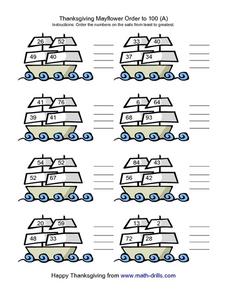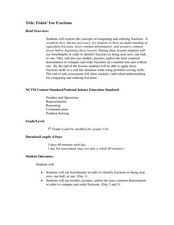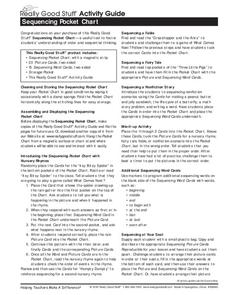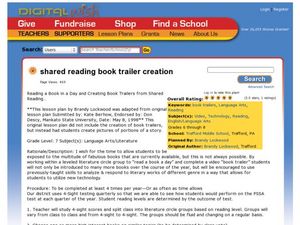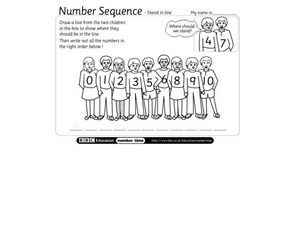Savvas Learning
Putting Shapes in Order
Challenge math scholars with polygon word problems that require logical reasoning. They answer two word problems about geometric shapes and their arrangement in a column based on clues given. Next, learners draw a robot made of...
Curated OER
In the Right Order
What comes first? Youngsters practice with sequence of events using a visual learning exercise, which has them examine three images to put things in order. For the first, they check off what comes before. For the next one, they...
Curated OER
Picture Story
In this story worksheet, students put pictures in order to tell a story and fill in the blanks to 2 different stories to complete them. Students complete 3 stories total.
Barbara Kowal
Winter Picture Test: Spell and Write
Scholars prove their vocabulary and spelling proficiency with a winter-themed picture test. Young learners study six pictures accompanied by a variety of letters that must be put in order to spell out the images' name.
Curated OER
Order Capacity
In this capacity worksheet, students put pictures in order from smallest to largest. Students put three pictures in order from each of the 4 problems.
For the Teachers
Story Strips Sequencing
What happens next? Work on story sequence with a lesson that prompts kids to put a story back in order. Additionally, they discuss what would happen if one event was missing from the sequence.
Helping Dyslexia
Picture Pairs Blends
Challenge your pupils to match words to images with these 29 pairs. Each word includes a consonant blend, either initial or final, and should be matched with its corresponding image either by simply putting two correct cards together or...
Helping Dyslexia
Picture Pairs Final Blends
Engage your pupils in learning final blends with a game of memory! Provided here are 44 word and image pairs to print and cut out in order to put together the game. Each word includes a final blend.
Curated OER
Comparing and Ordering Decimals - Complete Lesson Plan
Base ten blocks serve as visual representations of numbers that include decimals to the hundredths place. Children compare and order decimals in their math journal as they build the corresponding numbers with base ten blocks.
Curated OER
Transition Words in Writing
Transition words in writing are the focus of the language arts lesson presented here. In it, learners cut out the word-sort cards (embedded in the plan), and put them into four categories: time, examples, space, and summary. They find a...
Wise Owl Factory
Henry and Mudge
Henry and Mudge are best friends in Cynthia Rylant's book series featuring the adventures of a boy and his dog. Use this worksheet packet to accompany Henry and Mudge: The First Book and Henry and Mudge Take the Big Test. Learners...
Howard Hughes Medical Institute
Color Variation over Time in Rock Pocket Mouse Populations
A species-specific look at natural selection, the resource herein examines how adaptations have helped the population of rock pocket mice survive in a changing landscape. To begin, middle or high schoolers watch a 10.5 minute video,...
Curated OER
Maps and the Pictures in Our Heads
Geographers of all ages examine different types of maps. They draw maps of their environment, utilizing both three-dimensional and picture maps. They interpret map information, noting how it can sometimes be misleading. Some good...
Curated OER
Thanksgiving Mayflower Order to 100 (A)
In this math worksheet, students examine 4 two digit numbers in each set and put them in order from least to greatest. There are 8 sets of numbers, each in a picture of the Mayflower ship.
Curated OER
Fishin' For Fractions
Fifth graders compare fractions. In this fraction lesson, 5th graders identify whether a fraction is closest to zero, half, or one and use common denominators. They put fractions in order and complete real-life fraction questions.
Really Good Stuff
Sequencing Pocket Chart
Cut it out! Beginning readers practice sequencing skills at home or at school with a variety of activities that require cutting out multiple sets of picture cards and putting them in the correct order.
British Council
William Shakespeare
After watching a three-minute video detailing the life of William Shakespeare, scholars take part in several activities designed to show what they know about the famous writer. Learners read a series of eight sentences and put them in...
Concord Consortium
Yearbook Pictures
Sorting memories doesn't have to be difficult. Young mathematicians evaluate two different methods of sorting yearbook pictures. They answer a set of questions to explore each method, then develop their own sorting procedure based on...
Geography 360°
Poetry Writing
Put the tips and tricks in this guide into practice in order to encourage your pupils to blossom into poets. A wonderful reference material for teachers, this packet includes definitions of poetic terms and forms as well as step-by-step...
Curated OER
The Solar System - A Review
Students analyze their knowledge about the solar system. In this solar system review lesson, students look at a picture of the solar system on the SMART Board, name them in order, and are able to identify the sun as the center. They...
Curated OER
Shared Reading Book Trailer Creation
Scholars summarize sections of a book and compile them to create a book trailer. They are assigned sections of a book to read and summarize before recording as short video segments. The segments are put together in order to create a book...
Curated OER
Number sequence - stand in line
In this number line worksheet, students fill in the missing numbers to the number line through pictures of children with numbers on their shirts. Students fill in 2 missing numbers and then cut out the kids and put them in order.
Curated OER
Making Sentences in the Right Order
In this sentence construction worksheet, students complete 6 exercises in which a group of 4 to 5 words is analyzed and put in order to form a complete coherent sentence.
Curated OER
Phoneme Identification with Sound-it-Out Chips
Looking for a tangible way to help emerging readers identify phonemes? You've found it! They use chips without letters to segment single-syllable words into first, middle, and last sounds. As you say each sound, scholars place a chip on...















